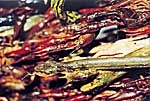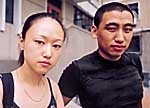
July 31, 1999 (Beijing)-Two dozen officials arrive
at an underground art studio, after a tip-off from a concerned citizen
who believes an illegal religious cult is organizing a meeting. The
two dozen men all sport pagers and mobile phones holstered at their
belts. Their bellies are all suitably large, and their trousers regulation
gray and dark blue. Each man carries a small leather case under one
arm.
They descend into the basement of an apartment building and are confronted
by broken toasters, photographs of masochistic performance art events,
paintings and flickering TV screens. Some of the men visibly recoil
as they approach a six-by-four-meter curtain made of living lobsters,
snakes and frogs strung together on wires. To get further into the basement,
they have to walk right next to the slimy curtain of slowly dying serpents
and sea creatures.
Like philosophers through the ages, the men ask: " What does this mean?
" A very pertinent question, as Life is the name of this exhibition
of unusual art works.
Unfortunately, by the time that the officials work out the meaning of
Life, some of the art works are dying and the exhibition, organized
without a license, is prohibited from opening.
Despite the comedy of the absurd that exhibition curator Li Zhenhua
is treated to, he is not laughing. Several months' work and an investment
of several thousand dollars went into planning the event, securing the
underground space and printing the catalogues. Since some of the artworks
are perishable, the exhibition cannot be moved or postponed, and no
one other than the organizers and the cadres get to see any of the works.

Li is a well-built 29-year-old man with a crew cut
who would look more at home in a gym than behind the scenes at an exhibition
of avant-garde art.
But he has been the motivating force behind a series of exhibitions
designed to encourage and promote experimental visual art. Li also organizes
rock and folk music concerts, has dabbled in the recording business
and run his own bar/art gallery.
Beijing's tight-knit circle of unofficial culture pundits is not always
easy to break into. Li hopes that his exhibitions and concerts are giving
new, lesser known artists exposure to audiences that they could not
get in any other way.
For this reason he was particularly disappointed by the closure of the
show. The centerpiece was the curtain of live animals, an installation
work entitled Curtain by young sculptress Peng Yu.
Peng is a 27-year-old graduate of the Zhejiang Academy of Art. Although
she majored in oil painting, she has been working as a sculptor and
installation artist since graduation, participating in a number of small
shows, mostly organized by groups of artists rather than galleries.
Peng's last work consisted of a group of sculptures of human figures
made from rough papier-maché.
Curtain was made from much more expensive materials: the lobsters, grass
snakes and bullfrogs cost rmb 8,000 at a seafood market. Although Peng
herself doesn't eat lobster, she wanted all the animals she used to
be common food items. " The aim of hanging strings of live food was
to make the viewer personally feel the problems of existence, " says
the artist, denying that the work was intended to disgust or shock.
" The completed work was really beautiful, " she argues.
Peng refers to Damien Hirst, the British artist whose formaldehyde-preserved
cows disgusted many art critics in the 1980s.
" The new materials that Hirst used to make art are now accepted and
no longer considered shocking, " she says.
Beijing artists have been exploring a range of rather shocking materials
in recent months. An exhibition entitled Post Sensibility (open for
a day in late 1998) contained several works made with limbs taken from
human corpses and even an entire fetus. Some western critics of Chinese
art took this use of alternative materials as a rejection of western
values, a rebellion by young artists tired of pandering to western tastes.
Peng disagrees: " This art is not specifically about being Chinese;
I hope it asks questions about life and existence that are common to
all people. "
Curtain is a work that would be branded cruel and politically incorrect
in many western countries. The work may not be intended as a rebellion
against western tastes, but it does raise relevant questions about the
different esthetic and ethical environments in which Chinese and foreign
artists are working. And asking such questions is surely one of the
purposes of art.
The lobsters, however, might not agree.